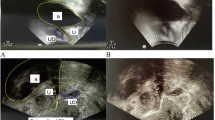Abstract
Introduction and hypothesis
The objective was to establish a model to predict the presence of a female urethral diverticulum (UD) based on symptoms.
Methods
A prospective CHECK-UD study (check of female urethral diverticulum) was conducted. Female patients presenting with symptoms such as lower urinary tract symptoms (LUTS), postmicturition dribble or urinary incontinence (UI), dyspareunia or pain in the pelvic area, and recurrent urinary tract infection (UTI) treated between 2015 and 2020 were included. The association between each symptom variable and the positive finding of UD was evaluated by multivariate logistic regression adjusting for age, body mass index (BMI), vaginal deliveries, previous surgery for SUI, previous pelvic surgery, and microscopic hematuria. A predictive model for the presence of UD was then created.
Results
In total, 189 female patients with a minimum of one symptom were enrolled. Pelvic floor ultrasound revealed the presence of UD in 66 out of 189 (34.92%). Of the four symptoms, the combinations “LUTS + postmicturition dribble + UTI,” “postmicturition dribble + LUTS,” and “UTI + LUTS” were most significantly related to positive findings and had a higher positive prognostic value for the diagnosis of UD than each individual symptom alone (OR = 13.78 [95% CI: 6.95–16.35], p < 0.001; OR = 9.94 [95% CI: 4.60–12.2], p < 0.05; and OR = 5.78 [95% CI: 1.58–6.98] p = 0.05) respectively.
Conclusion
Based on our model, the combination “LUTS + postmicturition dribble + UTI” seems to be the most sensitive combination of clinical symptoms predicting the positive finding of UD. This model could be used for patient counseling and for the identification of patients with UD.

Similar content being viewed by others
Abbreviations
- ICC:
-
Intraclass correlation coefficient
- ICIQ-SF:
-
Incontinence questionnaire short form
- ICS:
-
International Continence Society
- IUGA:
-
International Urogynecological Association
- LUTS:
-
Urinary tract symptoms
- MRI:
-
Magnetic resonance imaging
- OAB:
-
Overactive bladder
- PFUS:
-
Pelvic floor ultrasound
- UD:
-
Urethral diverticulum
- UI:
-
Urinary incontinence
- UTI:
-
Urinary tract infection
- VI:
-
Vaginal inspection
References
El-Nashar SA, Bacon MM, Kim-Fine S, Weaver AL, Gebhart JB, Klingele CJ. Incidence of female urethral diverticulum: a population-based analysis and literature review. Int Urogynecol J. 2014;25:73–9.
Stewart M, Bretland PM, Stidolph NE. Urethral diverticula in the adult female. Br J Urol. 1981;53:353–9.
Romanzi LJ, Groutz A, Blaivas JG. Urethral diverticulum in women: diverse presentations resulting in diagnostic delay and mismanagement. J Urol. 2000;164:428–4.
Reeves FA, Inman RD, Chapple CR. Management of symptomatic urethral diverticula in women: a single-centre experience. Eur Urol. 2014;66:164–72.
Stav K, Dwyer PL, Rosamilia A, et al. Urinary symptoms before and after female urethral diverticulectomy—can we predict de novo stress urinary incontinence? J Urol. 2008;180:2088–90.
Baradaran N, Chiles L, Freilich DA, Rames RA, Cox L, Rovner RS. Female urethral diverticula in the contemporary era: is the classic triad of the “3Ds” still relevant? Urology. 2016;94:53–6.
Aydin A, Ahmed K, Zaman I, Khan MS, Dasgupta P. Recurrent urinary tract infections in women. Int Urogynecol J. 2015;26(6):795–804.
Abrams P, Cardozo L, Fall M, Griffiths D, Rosier P, Ulmsten U. The standardisation of terminology of lower urinary tract function: report from the standardisation sub-committee of the International Continence Society. Neurourol Urodyn. 2002;21:167–78.
Ockrim JL, Allen DJ, Shah PJ, Greenwell TJ. A tertiary experience of urethral diverticulectomy: diagnosis, imaging and surgical outcomes. BJU Int. 2009;103(11):1550–4.
El-Nashar SA, Singh R, Bacon MM, Kim-Fine S, Occhino JA, Gebhart JB, et al. Female urethral diverticulum: presentation, diagnosis, and predictors of outcomes after surgery. Female Pelvic Med Reconstr Surg. 2016;22(6):447–452.9.
Santoro GA, Wieczorek AP, Dietz HP, Mellgren A, Sultan AH, Shobeiri SA, et al. State of the art: an integrated approach to pelvic floor ultrasonography. Ultrasound Obstet Gynecol. 2011;37(4):381–96.
Wieczorek AP, Stankiewicz A, Santoro GA, Woźniak MM, Bogusiewicz M, Rechberger T. Pelvic floor disorders: role of new ultrasonographic techniques. World J Urol. 2011;29(5):615–23.
Patel AK, Chapple CR. Female urethral diverticula. Curr Opin Urol. 2006;16:248–54.
Author information
Authors and Affiliations
Contributions
B.B: had full access to all the data in the study and takes responsibility for the integrity of the data and the accuracy of the data analysis, manuscript writing/editing, protocol/project development, data collection or management, drafting of the manuscript, administrative, technical, and material support; K.F.: data collection or management; S.H.: data collection or management; I.W.: drafting of the manuscript, critical revision of the manuscript, administrative, technical, and material support, supervision; B.H.: critical revision of the manuscript, administrative, technical, and material support, supervision; C.R.: administrative, technical, and material support, supervision.
Corresponding author
Ethics declarations
Ethical approval
All procedures performed in studies involving human participants were in accordance with the ethical standards of the institutional research committee and with the 1964 Declaration of Helsinki and its later amendments or comparable ethical standards. This article does not contain any studies with animals performed by any of the authors.
Informed consent statement
Patients were required to give informed consent to the study. Clinical data were obtained after each patient had agreed to treatment by written consent.
Conflicts of interest
I certify that all conflicts of interest, including specific financial interests and relationships and affiliations relevant to the subject matter or materials discussed in the manuscript (e.g., employment/affiliation, grants or funding, consultancies, honoraria, stock ownership or options, expert testimony, royalties, or patents filed, received, or pending), are the following: none. The authors declare that they have no relevant conflicts of interest.
Additional information
Publisher’s note
Springer Nature remains neutral with regard to jurisdictional claims in published maps and institutional affiliations.
Rights and permissions
About this article
Cite this article
Barakat, B., Franke, K., Hijazi, S. et al. Correlation between symptoms and imaging findings including pelvic floor ultrasound to improve the symptom-based diagnosis of female urethral diverticulum (CHECK-UD study). Int Urogynecol J 33, 2267–2274 (2022). https://doi.org/10.1007/s00192-021-04770-6
Received:
Accepted:
Published:
Issue Date:
DOI: https://doi.org/10.1007/s00192-021-04770-6




